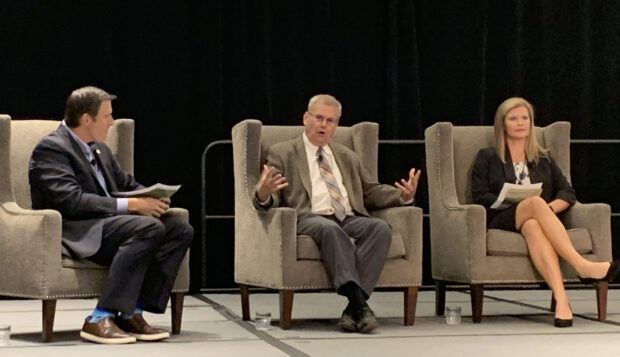HOME | ABOUT US | MEDIA KIT | CONTACT US | INQUIRE
HOME | ABOUT US | MEDIA KIT | CONTACT US | INQUIRE

There are more available jobs than there are required people to fill them in the United States, and the agriculture industry is at the extreme end of that scale.
Only 60 percent of professional job listings in agriculture are filled with college graduates in the field, leaving a 40-percent gap of unfilled jobs that need to somehow get filled, said Mark Stewart, president and chief executive officer of the Agricultural Future of America, speaking on a panel yesterday at the Ag Outlook forum at the Marriott Downtown.
“How do we make agriculture sexy to young people?” Stewart asked, pointing out later that “John Deere can’t even hire enough skilled labor.”
It’s a quest that Kansas City, Kan.-based Dairy Farmers of America struggles with, and tries to overcome, on a daily basis, said Jackie Klippenstein, senior vice president of government, industry and community relations, at the company. After all, the DFA, the largest private company in the Kansas City area, does about $14 billion in revenue and needs a constant influx of trained workers.
Sometimes that means recruiting outside of the traditional agricultural circles.
“We have fewer kids coming out of rural America into jobs because there are fewer kids coming out of rural America,” Klippenstein said. “I firmly believe that our workforce should look like who we provide our product to.”
That means reaching out to urban communities and tech-heavy universities. What many prospective employees might not understand is that DFA and similar companies in agriculture have just as much of a need for software engineers and IT experts as other industries.
The agricultural industry needs to make a more proactive approach to reach out to universities and let students know they types of jobs they have to offer, said Torree Pederson, president of Overland Park-based Aligned, an organization that links the business and education communities in workforce-development efforts.
That means business leaders need to speak to students about what their jobs entail. Many potential employees might be enticed by a career in food development, but might think they are automatically disqualified from getting that kind of job because they didn’t grow up on a rural area, and they need to understand that their perspectives might actually be an asset.
“The education system is ready for businesses to take a seat at the table,” Pederson said. “We have to be creative and make it fun for these kids to understand what we do.”